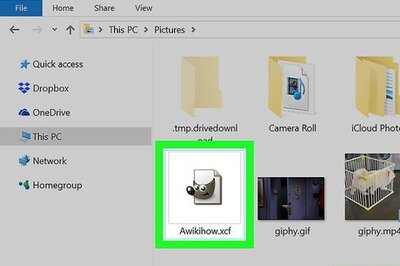
views
I am inspired by the official response and the disparagement which is doing the rounds on the issue of the perennial dog menace in Ghaziabad.
Being an ecologist, I felt it was my duty to educate those who have the responsibility to deal with the associated risks of dogs in gated societies and other urban habitations.
I have witnessed suggestions pouring in, starting from letters to the authorities to fencing in various areas of societies such as Shipra Suncity in Ghaziabad where I live. It is perhaps one of the biggest townships in the national capital region (NCR) and one of the oldest as well. We must understand that dogs cannot be stopped by fencing any geographical locality. Societies like Shipra Suncity are porous from almost all sides.
There are thousands of flats, hundreds of shops and more than a dozen big and small parks. A large number of outsiders also come for shopping to the markets inside the township. Many patients visit doctors at clinics in the locality.
Throughout India, there is no evidence anywhere of efficient management of stray dogs. The only way to control the menace is to contain their population through proper measures in collaboration with authorities. Very often, people are only interested in feeding the strays. But few are bothered about neutering as well as maintaining vaccination cycles for male and female dogs.
So, dog-loving residents need to form a ‘working group’ to make sure that every dog is vaccinated as well as neutered. It is the responsibility of residents’ associations to form such groups. The actual process of vaccination and neutering should be carried out by the municipal authority. So, residents’ associations should be in touch with the civic bodies for such programmes.
Dogs are highly territorial in nature. Because of this, no locality anywhere can be free of them for a long time. But for semi-gated neighbourhoods like Shipra Suncity, a certain number of canines could be maintained inside with proper care by dog-loving residents’ working groups along with cooperation of people of the society. These groups should monitor the entry of new dogs into the locality.
One should bear in mind that dogs are unlike monkeys who are wild in nature and do not like the proximity or touch of human beings. Today, controlling the population of monkeys in urban areas is not possible as vaccination or sterilisation of apes is neither doable nor advisable as it makes the simians hostile towards humans.
Fortunately, dogs don’t mind this as long as they are getting food and company. The canines have been associated with humans for over 10,000 years. However, violent dogs need to be isolated and handed over to municipal authorities.
So, only collective action by residents and authorities can mitigate the dog menace. Official letters always find the right places to gather dust.
The Ghaziabad municipal corporation has decided that a Rs 5,000 licence fee will be charged for owning a dog. If a dog is found defecating in parks, a fine of Rs 500 will be imposed on the owner. Irrespective of everything, the civic body must understand that there are limitations to enforcing any kind of rules for keeping pets at home. For example, in a society like Shipra Suncity, every lane has about 5-10 pet dogs and almost an equal number of stray dogs. So, the locality has a resident dog population of over 100, of which about half is of strays.
The number of government workers attending to issues pertaining to pet and stray animals in any municipal area in India is quite limited and Ghaziabad is also no exception. There is a behavioural trait often displayed by owners with respect to vaccination as well as sterilisation of their pets depending on the breed.
It can be seen that people owning more expensive breeds are frequently more punctual in maintaining the health of their pets. But these people are careless about public health as their pets relieve themselves outside their houses and no one is around to clean up afterwards.
Also, there are people who are concerned about stray animals. But, in most cases, this concern does not go beyond feeding them. Unorganised waste management attracts a large number of stray animals including dogs, monkeys, rats, etc, and so, an organised system of waste collection and disposal also needs to be accepted by residents.
In such a situation, other people in any urban housing society feel threatened by such semi-domesticated stray animals. There have been many incidents of attacks on residents by semi-domesticated stray dogs.
In a nutshell, besides the regulations related to dogs, behaviour of dog owners and dog lovers is also important. A participatory mechanism with coordination between residents’ groups and municipal bodies is the need of the hour so that the lives of locals are not threatened and pets and stray animals can be efficiently maintained.
Yogesh Gokhale is Senior Fellow, Forestry and Biodiversity Division in The Energy and Resources Institute (TERI)

















Comments
0 comment